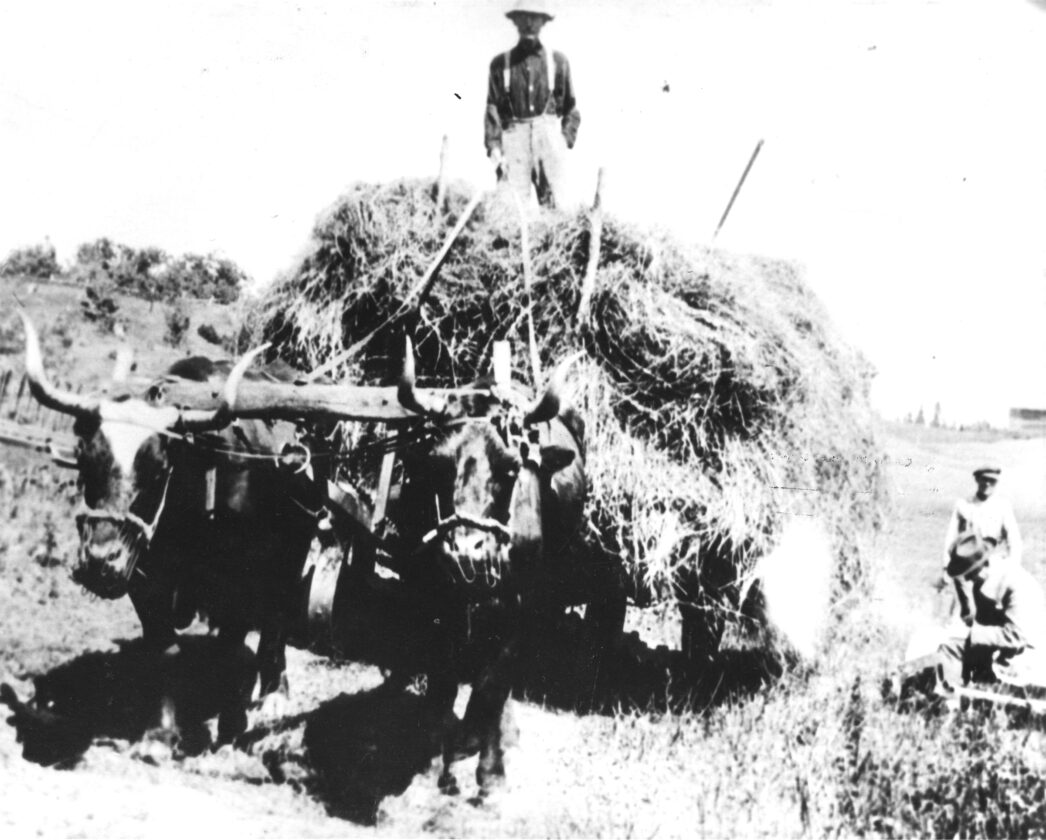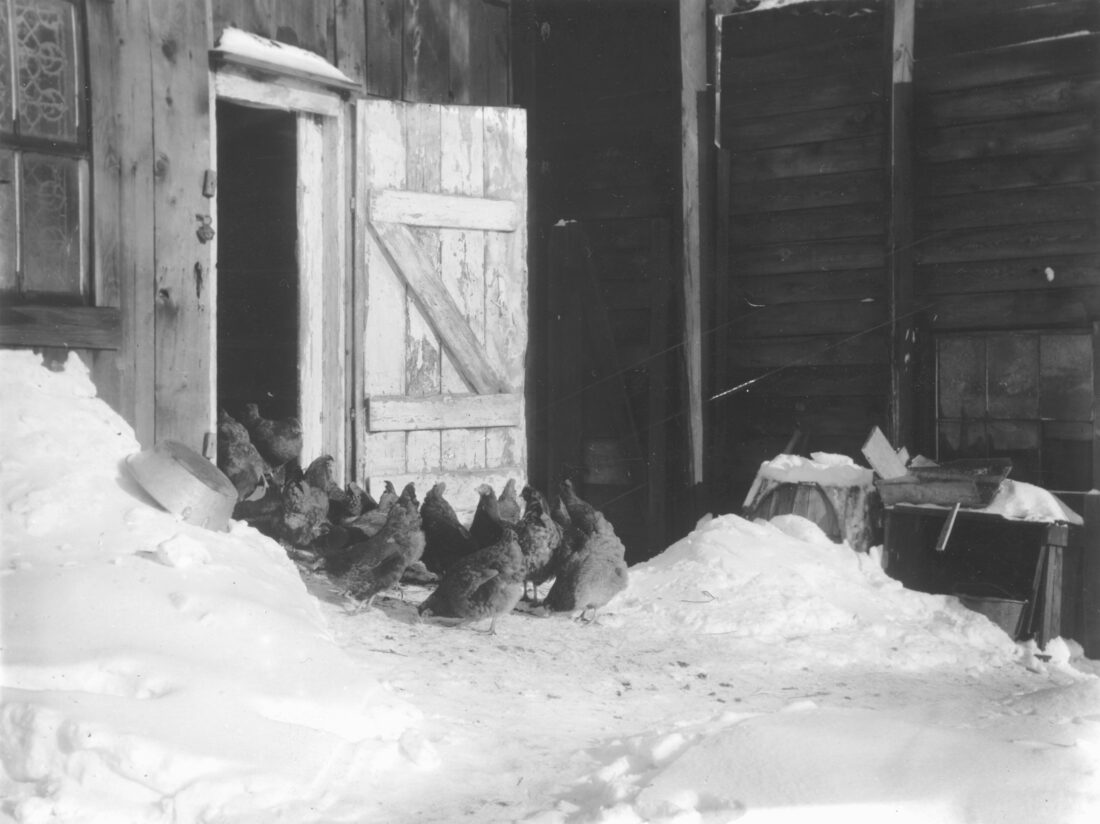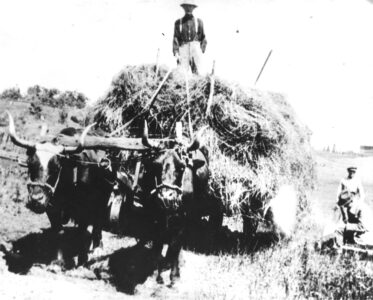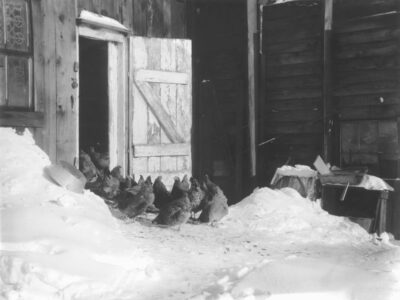Indigenous farming thrived well before white settlers

This photo shows the practice of haying with oxen. (Photo courtesy Marquette Regional History Center)
- This photo shows the practice of haying with oxen. (Photo courtesy Marquette Regional History Center)
- Chickens at a snowy farm yard stay flocked together. (Photo courtesy Marquette Regional History Center)
First mapped in the 1990s by NMU professor emerita Marla Buckmaster, the new studies used lidar, a technology that uses a drone-mounted laser to measure distances and create 3D maps.
Timed for the spring after the snowmelt and before the leaves had grown, archaeologists found parallel rows of earthen mounds covering more than 300 acres and which appear to continue beyond the surveyed area.
Dating from the Late Woodland period (around 1000 BCE) to around 1600 AD, the mounds are the remnants of raised gardening beds used by the ancestors of the Menominee Indian tribe of Wisconsin.
These fields were probably used to grow a combination of corn, beans and squash, often known by the Iroquois name the Three Sisters. This practice of planting multiple crops together is called intercropping. Intercropping allows the physical aspects of each plant to complement one another and improve each other’s health and growth.

Chickens at a snowy farm yard stay flocked together. (Photo courtesy Marquette Regional History Center)
With the Three Sisters, the corn stalks provide a natural trellis for the beans to grow on, which in turn help the corn grow by adding nitrogen to the soil. At the same time, the squash vines act as living mulch that maintains soil moisture and prevents weeds from growing.
Reliance on agriculture varied by tribe and location. Prior to this discovery, experts considered the Upper Peninsula to be too northerly to support this type of intensive farming. Additionally, archaeologists have not been able to locate any significant settlement sites in the region which would have necessitated such a large food source.
This level of intensive agriculture contradicts the “pristine myth” of early America. While many accounts of early explorers and settlers describe untouched lands, they failed to realize that these lands had reverted to wilderness following the decimation of tribal populations by European diseases such as smallpox and influenza.
Native Americans lacked immunity to these new pathogens, which spread quickly across the continent, wiping out anywhere from 25 percent to sometimes even 90 percent of tribal populations. As the population contracted, so did the Native American agricultural use, allowing old fields to be invaded by trees and other plant growth.
From historical records, local garden sites are known to have existed on Grand Island, near Munising, and along the Carp River in Marquette. The first recorded mention of the Carp River settlement was made by government surveyor William A. Burt.
On a June 25, 1844, on a survey map he noted there was an Indian village at the mouth of the Carp River, and upstream was an “Indian garden” on the south bank of the river. By this time, potatoes had been introduced to the Native Americans of the area, and this was probably the main crop cultivated at this site. Local Anishinaabe leader Mah-je-ge-zhik also told early settler Sidney Adams that he remembered a garden on Presque Isle.
Despite this significant local history of agriculture, Euro-American settlers brought their own techniques to the region. Following several of the treaties in which tribes ceded their land, including the Treaty of Washington in 1836 and the Treaty of La Pointe in 1842, one of the “benefits” the tribes received was a government-appointed “Indian Farmer.” The goal was to acculturate the Indigenous people by teaching them to farm in the European style with plows, fences, and to care for oxen which would clear the stumps.
Another part of the U.S. government’s assimilation policy was land allotments that were mandated by the 1887 Dawes Act. Rather than letting tribes hold their reservation lands communally, lands were divided up and allotted to individuals, encouraging them to adopt farming and private property ownership. The government firmly believed that ownership of private property led to material wealth and such wealth was an essential component of what they believed to be civilization.
Native Americans who accepted allotments and adopted the “habits of civilized life” were granted U.S. citizenship. Those who did not want to farm often sold their lands, usually to white settlers. Additionally, the “surplus” land remaining after the allotment was to be purchased by the government with the proceeds being held in trust by the government for the benefit of those Native Americans who had formally held the land by treaty. About a third of this land was then opened to white homesteaders.
The allotment policy created a checkerboard pattern of land ownership, with tribal lands interspersed with privately held lands. By 1920, over 90% of the land on some reservations, including the Oneida Reservation in northeastern Wisconsin, was owned by whites.
The turn of the 20th century saw continued changes to agriculture in the region, as the Industrial Revolution transformed small, self-sufficient family farms into a large, mechanized, scientific industry. The tractor, the telephone, and the automobile revolutionized cultivation, communication and transportation. Although farm conditions improved, people left farms in droves and resettled in cities.
As the century continued, Michigan’s agriculture increased specialization based on the state’s various soils, topographies and climates. Potatoes in sandy soils of the north, navy beans in the Saginaw Valley, sugar beets in the Thumb area, fruit along the Lake Michigan shore, the list goes on.
However, farmers are now less self-sufficient, and scientific techniques have resulted in fewer and larger farms, bigger yields, and greater use of fertilizer and mechanization.
The 21st century is seeing a movement toward sustainable agriculture techniques like companion planting, no-till gardening, crop rotation and using natural fertilizers, all while respecting the land’s natural rhythms. These practices promote biodiversity, soil health and ecological balance and are often rooted in traditional Native American farming practices.
The sustainable farming movement is trying to bring Michigan farming full circle, back to its Native American roots.






